| |
MUSEUM OF THE NATIONAL ANTHEM IN BEDOMIN
Jozef Wybicki, the author of Polish national anthem was born and spent his adolescence in a small noble manor in Bedomin. For over 40 years, between 1741 and 1783, the manor belonged to the Wybickis and at present the Museum of the National Anthem is located here. It is the only place of this kind in the world. In the beginning, in 1962, Jozef Wybicki Memorial Chamber was created, and in the centre of Koscierzyna, next to the main street, the only statue of the author of the national anthem in Poland, 11 m high, was erected. In 1966 during Adam Mickiewicz Polish Literary Association Conference the manor was voted a national memorial and it was decided that a museum was to be set up here. It was open in 1978. The collections referring to the history of Polish national anthem come from all over the world. The most valuable exhibits are: sheet music and text of "Dabrowski's Mazurka" issued in Paris in 1856 in Polish and French, two travesties of the anthem in German from 19th century and a gramophone record with recording of the anthem issued in 1902 by Columbia Phonograph Company. There are also tens of gramophone records with the eldest recordings of Polish patriotic songs: "Boze cos Polske", "Warszawianka", "Choral", "Rota" and others.
WIEZYCA HILL
Wandering through Kashuby from many places can you see Wiezyca Hill (328,6m above sea level) - the highest hill on Great European Plain. Its slopes are grown with beech forest in which you can find even 150-year old trees. Tourists have visited Wiezyca since mid-19th century, when vantage points were very popular. At the end of 19th century on the top the first, wooden lookout tower was erected, it was dismantled before the outbreak of the 1st World War. Later two more wooden towers were built. For some years now a solid metal construction with a big viewing platform has been here. It is visited by many tourists. You have a great view over Szymbark Hills, Gold Mountain, Radunskie Circles and Kashubian Road from it. A lot of you will be charmed and impressed by a picturesque panorama of Kashubian Switzerland. Green and blue are dominant colours in this exceptional landscape. Some people joke, that when the weather is fine you can see Gdanska Bay, Koscierzyna and Kartuzy. In winter southern slopes of Wiezyca Hill are full of skiers and tobogganners, and nearby forest roads are full of sledging cavalcades and in the end the enthusiast of such pastimes gather by bonfires. You must admit that a stay in Kaszubian Switzerland can be a fascinating experience.
THE LONGEST BOARD IN THE WORLD (Szymbark)
Just a few kilometres from Wiezyca there is the Centre for Education and Regional Promotion in Szymbark where you can see the longest board in the world registered in the Guinness Book of World Records in 2002. It was made from a Douglas fir over 51 metres high. The board is 36,83 m long and is 2,76 m longer than the previous record holder from Austria (1996 - a cut out board 34,07 m long). The board in Szymbark is under a wooden umbrella roof next to the Nobel prize holder's - Lech Walesa's table (weight - 6 tons).
SKI-LIFT
Kashuby are rather a place for water sports or cycling, but ski-lovers can also find something for themselves here. In Szymbark, near Kartuzy there is a ski station KOSZALKA with three well-lit ski runs 200-400m long and with a 45-60m difference in level. The ski runs are open 10:00-20:00.
WESIORY STONE RINGS
Stone rings reserve can be found in the middle of a slope among young forest at Dlugie Lake. 27 stones prove that noble people were buried here. At the top of the hill rings that had ritual significance can be found, according to water diviners they have very strong radiation. Particularly negative affect has a small mound of different size stones.
PAPAL ALTAR IN SIERAKOWICE
A sculpture situated near St. Martin's church - a monument with altar, at which Pope John Paul II celebrated a mass in Pelplin during his seventh trip to his Fatherland is called papal altar. It is a special place with natural, architectural and sacral element intertwined, which gives the visitors not only the possibility to walk and see or admire the green architecture, but also a place which stimulates meditation, reflection and contemplation. According to the author - the concept combines three aspects. First of all - a dragnet as a symbol of God's Kingdom: " Again, the kingdom of heaven is like a net thrown into the sea, which collects fish of every kind." (Mt.13:47) Secondly - the effort of John Paul's II pilgrimage to convert and "fish" people for God: “Do not be afraid; from now on you will be catching people.” (Luke 5:10) Thirdly - a dragnet, as a basic tool for fishermen is the best symbol of Pomerania, and at the same time it is a personal call for us: “Follow me, and I will make you fish for people.” (Mt. 4:19).
ST. MARTIN'S CHURCH
The eldest sacral building in Sierakowice community. The wooden part was built between 1820 and 1822, and the brick part in 1903. The church has 6 altars dating from 18th and 19th centuries.In the bell tower there are 3 bells from 1918, 1933 and 1958.
FORMER MONASTERY IN KARTUZY
The sanctuary built at the beginning of the 14th century, with small alterations, is preserved in its primary form until today. Great renaissance furnishings make it one of the most interesting sanctuaries in Kaszuby. Until 19th century it was a monastery of Carthusian order, which was closed in 1823 by the Prussian authorities and most of the monastery buildings were destroyed. When visiting the church it is worth to notice the 17th century cordovans (richly ornamented wall facing made of kidsuede), Renaissance main altar and side altars, and Baroque gallery railing from 1640, as well as 14 precious religious paintings from 17th century. The church has a characteristic roof in the shape of a coffin, which is an architectonic symbol of the town until this day.
Near the monastery situated by Klasztorne Lake there is a forest called Swietopelk Grove. A part of the Grove is Philosophers' Avenue running along the shore of Klasztorne Lake. In the old days it was the monks' favourite place for contemplation. Today the town's inhabitants like to walk here spending nice time in the nature. Walking along Philosophers' Avenue we will get to an equally charming place called the Swan's Island. At the weekends in the summer open-air events take place here.
KASHUBIAN MUSEUM IN KARTUZY
The history of the Kashubian Museum is connected with the person of it's founder and first custodian - Franciszek Treder. Treder received help from Kashubian activists, who set up Kashubian Museum Lovers Society. Thanks to the initiative and endeavour of the Society, the Museum was given 19th century mansion left by the Public Security Office. That is where the Kashubian Museum has its seat until today. The Kashubian Museum was officially opened on 1 May 1947. The visitors can see ethnographic and archaeological exhibits. In 1949 the first exhibition of Kashubian folk art was held. As of 1 January 1950 the Museum is state owned. The first manager and custodian, until retirement, was Franciszek Treder. The next chapter in the Museum's history lasted until 1990. It was the period when the Museum was subsided only by the state. Financial means were scarce and needs considerable. Treder, realising this fact, tried to win supporters by substantiating the need of having a Kashubian Museum. The Museum managed by Treder started to develop dynamically. Today the Museum first and foremost publicises culture presenting the achievements of Kashubian culture to tourists and school children. The Kashubian Museum exhibits rich ethnographic collections dedicated to farming, household, fishing, ceramics, celebrations and Kashubian folk art, as well as historic memorabilia related to Kashuby. The exhibits have been placed in seven exhibition rooms of the main building.
OPEN AIR STEAM LOCOMOTIVE MUSEUM
This is where the time has stopped for the best traditions of Polish railroad engineering. In this historic place memories of amazing and rich history of railroad in Poland return. Visiting the railroad exhibition in Koscierzyna enables you to have direct contact with fascinating technology of the bygone years. We offer to see: rectangular, through-hall for four steam engines, exhibition halls and old steam locomotives, carriages, railroad devices in the open air. In the museum halls you can see tools, machines, elements of old mechanism no longer used and also a collection of documents, memorabilia and models.
WDZYDZE LAKE (Jezioro Wdzydze)
This beautiful lake is called Kashubian Sea by the locals. It is one of the best known places in Kashuby, each year swarming with tourists. Together with the adjacent land it is under protection of the Wdzydze Landscape Park. The lake is 1455 hectares big and up to 68 metres deep. It is a postglacial lake in a shape of a great cross, out of which ten islands emerge, the biggest are: Wielki Ostrow, Maly Ostrow, Glonek and Sorka. It is a real paradise for sailors and kayakers, because a popular kayaking route of the Wda River runs through the lake. At the same time it is the only place in Poland where a population of grand sea trout (Wdzydze Trout) lives, which attracts anglers from distant places. Water sports enthusiast can try a kayak trip down the Slupia River. The route starts in Gowidlinskie Lake. The Slupia Valley trip is considered as a difficult though very interesting route. Sailing through the territory of the Lanscape Park you must use the camping sites provided. By the road bridge Jasien-Bytow you can see ruins of an aqueduct. We also recommend kayak trips down the Wda River and the Brda River.
OPEN-AIR KASHUBIAN MUSEUM IN WDZYDZE KISZEWSKIE.
It is the eldest Polish open-air museum. The Museum has been developed over the years and now displays the buildings from Kashuby and Kocievie since the 18th century until the end of the first half of the 20th century. Circa 40 buildings occupy the area of 22 hectares. The location at Golun Lake is an advantage of the Museum. The museum is attractive for visitors all year round - especially for people who value silence and quality of the nature.
KASHUBIAN GOLGOTHA IN WIELE (KARSIN COMMUNITY)
Sanctuary in Wiele. Kashubian Sanctuary of Jesus' passion and death in Wiele was build to commemorate the victims of the First World War. Wejherowo Golgotha was taken as a model. 23 structures (14 shrines, 6 sculptures, holy stairs, a pulpit and a hermitage) situated on picturesque slopes of White Mountain (Biala Gora) at Wielewskie Lake. Wiele Golgotha, which religious motive is worship of the Mother of Consolation, is a monument of love of the Kashubs for their Motherland.
MIRACHOWO CAVES (GROTY MIRACHOWSKIE)
Caves at Lubygość Lake are known as Mirachowo Caves; they are 3 and 6 meters long respectively and were discovered at the turn of 50s and 60s as a result of a sand and gravel-pit operation at the northern shore of the lake. The bigger of the caves is rather a "rock" than a "cave" as it is a small overhang connected with a 2-metre high column. This column is clearly slowly moving and the bay resembling slightly a rock mushroom is broken and looks like its going to collapse.
THE RADUNIA CANYON
The Radunia River bursts forward here with a speed of a mountain brook through a tight gorge, known in Kaszuby as the Radunia Canyon. Water in this gorge shoots and foams washing under steep slopes. This deep canyon is six kilometres long and covers the area of 84,24 hectares.
THE PALACE IN LEZNO
It was first mentioned in the 14th century. At the moment the Lezno Palace operates as a Conference Hall for Gdansk University. Apart from conferences also celebrations and meetings of exclusive societies are held here. There are eight apartments consisting of a sitting-room, a bedroom and a bathroom in the palace. In the basement there is a hunter style café. In the first floor there is a conference room for sixty people, three, fully equipped seminar rooms and a study with a computer and the Internet access.
HYDROELECTRIC POWER STATION IN RUTKI
Power station built by the Germans between 1910 and 1911 as a part of Radunia Power System. After 1920 Rutki became a power station supplying power to Kartuzy county and Gdynia's construction.
ARCHAEOLOGICAL ATTRACTIONS OF SOMONINO COMMUNITY
Right out of Borcz there are some single menhirs which are difficult to connect in a particular shape, but which were probably a part of a bigger construction. In front of the tumuluses on the left side of the road there is a small fenced area, which bears signs of excavation - rectangular cuts in the turf, a mound of stones. An ancient sacrifice altar was found, there used to be a small lake here, on the bottom of which pieces of ceramic pots and fire stones were found. According to the latest research, people of East Pomeranian culture used to bury their dead here before the Goths. Tumuluses in Wyczechowo are not far away.
THE ELEVATION OF THE HOLY CROSS CHURCH IN LESNO
The Elevation of the Holy Cross Church in Lesno is one of the best preserved and the most original wooden churches in Kaszuby. The existence of the church and the parish in Lesno is confirmed by sources only of 1534. In this year the church in Lesno is mentioned in the inventory of goods of a Wroclaw bishop. At that time it was St. Catherine's Church. In the reformation period, at the end of the 15th century it lost its status as a parish church and was a succursal church of Brusy. A new church was built between 1634 and 1687. The year 1687 was a year of another bishop's visit. At that time church changed its name. According to the Parish Chronicle queen Marie Louise Gonzaga founded the new 17th century church.
ARCHAEOLOGICAL ATTRACTIONS OF PRZYWIDZ COMMUNITY
In Przywidz remnants of a Slavic settlement from the end of the period was found; it can be probably connected to the village mentioned in historic sources from the end of the 13th century. In the forest on the border of Przywidz, Pieklo Dolne and Gorne there are remnants of a destroyed tumulus burial ground, one of the biggest in the Gdansk Pomerania. Also an early-mediaeval town ruins can be found on the peninsula of Przywidzkie Lake, in Gromadzin. Such towns were centres of local mastery of early-mediaeval Slavs. Pieces of pottery, charcoal and pieces of bricks came from the town, and in the 19th century also coins and decorations from the end of 10th and beginnings of the 12th centuries were discovered here. They included Slavic, German and English coins and also a piece of an Arab coin. Also a stone hand-mill is probably early-medieval as well as an iron sword found in a bog in the 19th century. Most of the archaeological discoveries in Przywidz was done before the Second World War, and the first information about discoveries date even to mid-19th century. As a result of war relics gathered in the Gdansk Museum as well as the documentation of the discoveries were lost. It makes it difficult to reconstruct ancient colonization of this area. Slavic town ruins and destroyed tumuluses out of Pieklo were registered as archaeological relics of the Gdansk province and are protected by law.
CASTLE IN BYTOW
It was constructed on the turn of the 14th and 15th century and after the Teutonic Order Castle in Malbork it is the biggest of the preserved castles of this kind. It was rebuilt and restored many times over the centuries. The castle is composed of four houses: Monastery House, Princes' House, Widows' House, Court House. In the corners there were four towers: Powder Tower, Field Tower, Rose Tower and Mill Tower. In the Middle Ages, beyond the line of the wall there was a latrine tower, which also was a point of final defence. Formerly in front of the castle, on the place of the Court, there was a Gate Tower with a draw-bridge. At present there is a West-Kashubian Museum in the Castle, which holds temporary exhibitions and a permanent ethnographic exhibition on Bytow Kashubs culture relics. In one of the wings there is a hotel and a restaurant.
ST. GEORGE'S CHURCH IN BYTOW
St. George's Church built between 1675-1685, a former evangelic church (German - Bergkirche St. Georg) in a charcteristic half-timbered style, at present, after a general renovation in the 1980s, an Orthodox church, where you can see a tabernacle from a 17th century Orthodox church in Surochow, iconostas (Tsar's Gate) and a church dome in the style of Byzantine architecture. The first St. George's church was built probably in the second half of the 15th century and was destroyed by fire in 1629. All the saved furnishings from the end of the 15th and the 18th centuries can be found in the West-Kashubian Museum in Bytow. The sanctuary was called a "Kashubian Church" because Kashubian masses were held here until 1859, it was also a place where pastor Szymon Krofey gave his priestly services. Location: ul. Parkowa 4, Bytow.
NATURE RESERVE "BEECH HILL" [BUKOWA GORA] BY PYSZNO LAKE
The forest reserve was established in 1982 in order to save beech standing timber with many monumental trees about 220 years old. The reserve covers the area of moraine hills by Pyszne Lake, which are covered by high, old beech and oak standing timber with single pines and firs. In the ground cover one can find: common ivy, wood melick, (Melica uniflora), mountain pea (Lathyrus montanus Bernh.) and orchard grass (Dactylis aschersoniana Graebn.). In the reserve you can find the evangelic cemetery of foresters, the only in Pomerania. Since 1837 it has been a place of eternal rest of foresters and workers of Sierzno forest district and their families. There is for example the grave of a royal chief forester Otto Heinrich Smalian (1827 - 1874) with an impressive monument and inscriptions and the grave of a royal chief forest inspector for Koszalin Regency, Fridrich Adolph Olberg (1805 - 1878). Otto Smalian was the author of the formula for calculating a log volume of timber, which is used until today. Lately Osusznica forest inspectorate set a nature and history walk route called "Otto Smalian's Route". The route is 1,5 km long and was divided into stages, including the cemetery of German foresters, Pyszne lake, tumuluses, marked by information tables.
NATURE WALK ROUTES IN THE VICINITY OF REKOWO
The routes were set by the Municipality Office in Bytow. The route called "Nature attractions of Rekowo neighbourhood" is marked in green and leads towards west from the village up to the highest moraine hill of Bytow Lake District - to Siemierzycka Mountain. Valuable points in the route are lobelia lakes and kettlehole moss peat-bogs (morasses). The route is 6 km long and goes through mixed and pine forests, partially along lake shores. It takes about 4 hours to go through the whole route and 5 education points. And the route called "Among forest lakes and bogs" is marked in red and goes through forests east of Rekowo. The route is specialised and mostly deals with water and bog ecosystems. The route is about 7,5 km long and it takes about 4 hours to go through the whole route (3 education points). You can see valuable nature points (lobelia lake and kettlehole moss peat-bogs), which are planned to be covered with reserve protection.
| |
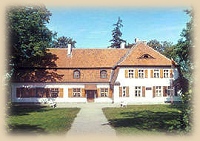
Museum of the National Anthem in Bedomin
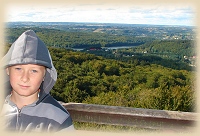
Wiezyca - view from the viewing tower
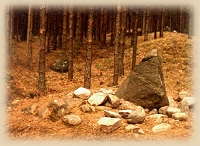
Wesiory Stone Rings
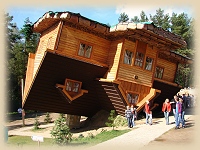
Szymbark - the Upside Down House
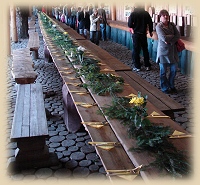
Szymbark - the longest board in the world
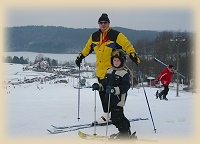
Wiezyca - ski lift
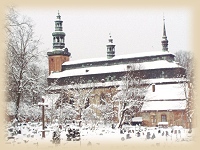
Former Monastery in Kartuzy
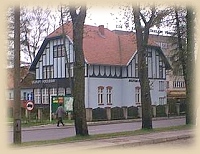
Kashubian Museum in Kartuzy
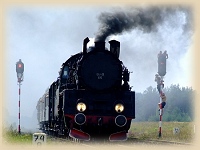
Open Air Steam Locomotive Museum
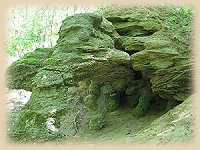
Mirachowo Caves (Groty Mirachowskie)
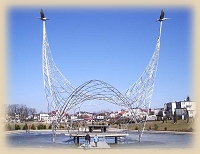
Papal Altar in Sierakowice
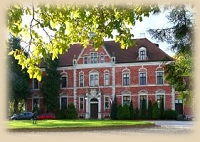
The Palace in Lezno
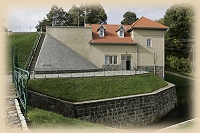
Hydroelectric Power Station in Rutki
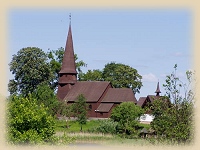
The Elevation of the Holy Cross Church
in Lesno
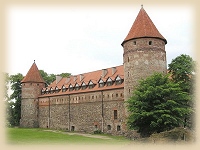
Castle in Bytow
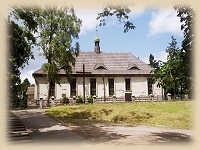
St. George's Church in Bytow
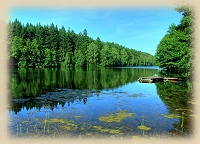
Nature Reserve "Beech Hill" by Pyszno Lake
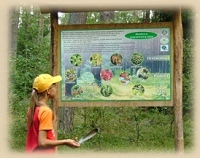
Nature Walk Routes in the Vicinity of Rekowo
| |







